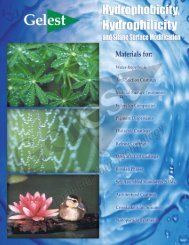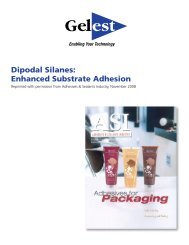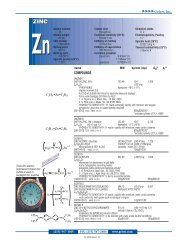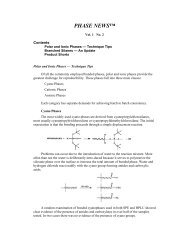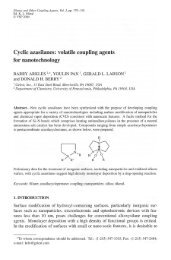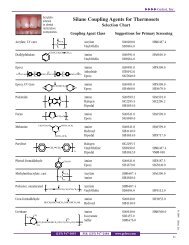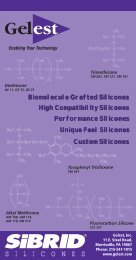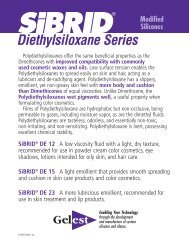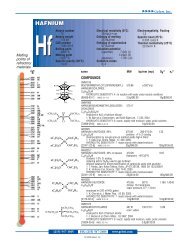Applying a Silane Coupling Agent (17 Kb)
Applying a Silane Coupling Agent (17 Kb)
Applying a Silane Coupling Agent (17 Kb)
Create successful ePaper yourself
Turn your PDF publications into a flip-book with our unique Google optimized e-Paper software.
APPLYING A SILANE COUPLING AGENT<br />
NOTE — Product codes in the tables are not links. Please use the Product Search functions to<br />
obtain detailed information about these products.<br />
Deposition from aqueous alcohol solutions is the most facile method for preparing silylated<br />
surfaces. A 95% ethanol / 5% water solution is adjusted to pH 4.5–5.5 with acetic acid. <strong>Silane</strong> is<br />
added with stirring to yield a 2% final concentration. Five minutes should be allowed for<br />
hydrolysis and silanol formation. Large objects, e.g. glass plates, are dipped into the solution,<br />
agitated gently, and removed after 1–2 minutes. They are rinsed free of excess materials by<br />
dipping briefly in ethanol. Particles, e.g. fillers and supports, are silylated by stirring them in<br />
solution for 2–3 minutes and then decanting the solution. The particles are usually rinsed twice<br />
briefly with ethanol. Cure of the silane layer is for 5–10 minutes at 110°C or 24 hours at room<br />
temperature (60% relative humidity).<br />
For aminofunctional silanes such as SIA0610.0 and SIA0589.0 this procedure is modified by<br />
omitting the addition of acetic acid. The procedure is not acceptable for chlorosilanes as bulk<br />
polymerization often occurs. <strong>Silane</strong> concentration of 2% is a starting point. It usually results in<br />
deposition of trialkoxysilanes as 3–8 molecular layers. Monoalkoxysilanes are always deposited<br />
as monolayers or incomplete monolayers. Caution must be exercised if oven curing. Exhausted,<br />
explosion-proof ovens must always be used.<br />
Deposition from aqueous solution is employed for most commercial fiberglass systems. The<br />
alkoxysilane is dissolved at 0.5–2.0% concentration in water. For less soluble silanes, 0.1% of a<br />
non-ionic surfactant is added prior to the silane and an emulsion rather than a solution is<br />
prepared. If the silane does not contain an amine group the solution is adjusted to pH 5.5 with<br />
acetic acid. The solution is either sprayed onto the substrate or employed as a bath dip. Cure is at<br />
110–120°C for 20–30 minutes.<br />
Stability of aqueous silane solutions varies from hours for the simple alkyl silanes to weeks for<br />
the aminosilanes. Poor solubility parameters limit the use of long chain alkyl and aromatic silanes<br />
by this method. Distilled water is not necessary, but water containing fluoride ions must be<br />
avoided.<br />
Bulk deposition onto powders, e.g. filler treatment, is usually accomplished by a spray-on<br />
method. It assumes that the total amount of silane necessary is known and that sufficient adsorbed<br />
moisture is present on the filler to cause hydrolysis of the silane. The silane is prepared as a 25%<br />
solution in alcohol. The powder is placed in a high intensity solid mixer, e.g. twin cone mixer<br />
with intensifier. The solution is pumped into the agitated powder as a fine spray. In general this<br />
operation is completed within 20 minutes. Dynamic drying methods are most effective. If the<br />
filler is dried in trays, care must be taken to avoid wicking or skinning of the top layer of treated<br />
material by adjusting heat and air flow.<br />
Integral blend methods are used in composite formulations. In this method the silane is used as<br />
a simple additive. Composites can be prepared by the addition of alkoxysilanes or silazanes to<br />
dry-blends of polymer and filler prior to compounding. Generally 0.2 to 1.0 weight percent of<br />
silane (of the total mix) is dispersed by spraying the silane in an alcohol carrier onto a preblend.<br />
The addition of the silane to the non-dispersed filler is not desirable in this technique since it can<br />
lead to agglomeration. The mix is dry-blended briefly and then melt compounded. Vacuum<br />
devolatization of byproducts of silane reaction during melt compounding is necessary to achieve<br />
optimal properties. Properties are sometimes enhanced by adding 0.5–1.0% of tetrabutyl titanate<br />
or benzyldimethylamine to the silane prior to dispersal.
Deposition as a primer is employed where a bulk phase is required as a transition between a<br />
substrate and a final coating. The silane is dissolved at 50% concentration in alcohol. One to three<br />
molar equivalents of water are added. The mixture is allowed to equilibrate for 15-20 mins. then<br />
diluted to 10% concentration with a higher boiling point solvent. Materials to be coated with the<br />
primer are dipped or sprayed and then cured at 110–120°C for 30–45 mins.<br />
Chlorosilanes such as SIV9110.0 may be deposited from alcohol solution. Anhydrous alcohols,<br />
particularly ethanol or isopropanol, are preferred. The chlorosilane is added to the alcohol to yield<br />
a 2–5% solution. The chlorosilane reacts with the alcohol producing an alkoxysilane and HCl.<br />
Progress of the reaction is observed by halt of HCl evolution. Mild warming of the solution (30–<br />
40°C) promotes completion of the reaction. Part of the HCl reacts with the alcohol to produce<br />
small quantities of alkyl halide and water. The water causes formation of silanols from<br />
alkoxysilanes. The silanols condense on the substrate. Treated substrates are cured for 5–10 mins.<br />
at 110°C or allowed to stand 24 hours at room temperature.<br />
Chlorosilanes and silylamines may also be employed to treat substrates under aprotic conditions.<br />
Toluene, tetrahydrofuran, or hydrocarbon solutions are prepared containing 5% silane. The<br />
mixture is refluxed for 12–24 hours with the substrate to be treated. It is washed with the solvent.<br />
The solvent is then removed by air or explosion-proof oven drying. No further cure is necessary.<br />
This reaction involves a direct nucelophilic displacement of the silane chlorines by the surface<br />
silanol. If monolayer deposition is desired, substrates should be predried at 150°C for 4 hours.<br />
Bulk deposition results if adsorbed water is present on the substrate. This method is cumbersome<br />
for large scale preparations and rigorous controls must be established to ensure reproducible<br />
results. More reproducible coverage is obtained with monochlorosilanes.<br />
Silazanes such as SIH6110.0 and SID4612.0 may be used as treatments in concentrated form or<br />
as 10–20% solutions in aprotic solvents. In some applications parts are exposed for 5–10 minutes<br />
by dipping or in microelectronics by spin-on techniques. Optimum reactivity is as 30–50°C. An<br />
alternate method of treatment is to expose parts to 50°C vapor for 2–6 hours. Ammonia is the<br />
byproduct of silazane reaction and areas should be ventilated.<br />
REFERENCES<br />
D. Leyden, W. Collins, “Symposium and Silylated Surfaces” Gordon & Breach 1980.<br />
B. Arkles, “Tailoring Surfaces with <strong>Silane</strong>s” Chemtech 7, 766 (1977).<br />
E.P. Plueddemann, “<strong>Silane</strong> <strong>Coupling</strong> <strong>Agent</strong>s” Plenum N.Y. 1982.<br />
K.L. Mittal “<strong>Silane</strong>s and Other <strong>Coupling</strong> <strong>Agent</strong>s” VSP, 1992.<br />
APPENDIX<br />
Calculation of necessary silane to obtain minimum uniform multilayer coverage can be obtained<br />
knowing the values of the specific wetting surface of silane (ws) and the surface area filler<br />
amt. of silane (g) =<br />
Relative surface area of common fillers m 2 /g<br />
amount of filler x surface area of filler<br />
specific wetting surface<br />
E-glass 0.1–0.12 Talc 7<br />
Silica, ground 1–2 Si, diatomaceous 1–3.5<br />
Kaolin 7 Calcium silicate 2.6<br />
Clay 7 Silica, fumed 150–200<br />
Talc 7<br />
Si, diatomaceous 1–3.5
COUPING AGENT RECOMMENDATIONS<br />
THERMOSETS — TABLE 1<br />
Resin <strong>Silane</strong> Class Gelest Product Code Examples<br />
diallylphthalate amine SIA0589.0 SIA0591.0 SIA0610.0<br />
SIA059.0<br />
styryl<br />
SIS6994.0<br />
epoxy amine SIA0591.0 SIA0610.0 SIT8398.0<br />
epoxy SIG5840.0 SIE4670.0 SIG5832.0<br />
imide amine SIA0610.0 SIA0588.0 SIP6724.0<br />
chloromethylaromatic SIC2295.5 SIC2296.2<br />
melamine amine SIA0589.0 SIA0591.0 SIA0610.0<br />
SIG5840.0 SIE4670.0<br />
paralene chloromethylaromatic SIC2295.5 SIC2296.2<br />
vinyl/allyl SIV9112.0 SIV9220.0 SIA0540.0<br />
phenolic amine SIA0610.0 SIA0591.0 SIA0605.0<br />
epoxy SIG5840.0 SIE4670.0<br />
photoresist, negative silazane SID4612.0 SIH6110.0<br />
aromatic SIP6821.0 SIP6722.6<br />
photoresist, positive silazane SIH6110.1<br />
phosphine<br />
SID4558.0<br />
aromatic SIP6821.0 SIP6722.6<br />
polyester, unsat’d amine SIA0589.0 SIA0591.0 SIA0610.0<br />
methacrylate/vinyl SIM6487.4 SIM6487.5 SIV9112.0<br />
styryl<br />
SIS6994.0<br />
urethane amine SIA0591.0 SIA0610.0 SIT8398.0<br />
epoxy SIG5840.0 SIE4670.0 SIF5832.0<br />
isocyanate<br />
SII6455.0
THERMOPLASTICS — TABLE 2<br />
Resin <strong>Silane</strong> Class Gelest Product Code Examples<br />
polyacetal quaternary SIS6994.0 SIT8405.0<br />
polyacrylates methacrylate SIM6487.4<br />
ureido / amine SIU9055.0 SIA0610.0<br />
polyamides amine SIA0589.0 SIA0591.0 SIA0610.0<br />
SIA0605.0 SIU9055.0<br />
polyamide-imide amine SIA0610.0 SIA0588.0 SIP6724.0<br />
SIC2295.5 SIC2296.2<br />
polybutylene amine SIA0591.0 SAI0610.0 SIT8398.0<br />
terephthalate isocyanate SII6455.0<br />
polycarbonate amine SIA0591.0 SIA0610.0 SITU9055.0<br />
polyethylene amine SIA0591.0 SIB1833.0 SIT8398.0<br />
vinyl SIV9112.0 SIV9220.0<br />
polyphenylene sulfide mercapto/thio SIM6475.0 SIB1825.0<br />
amine SIA0591.0 SIA0610.0 SIT8398.0<br />
polypropylene styryl SIS6994.0<br />
aromatic SIP6821.0 SIP6722.6 SIP6724.0<br />
polystyrene aromatic SIP6821.0 SIP6722.6 SIP6724.0<br />
polysulfone amine SIA0591.0 SIA0610.0 SITU9055.0<br />
polyvinylbutyral amine SIA0591.0 SIB1833.0 SIT8398.0<br />
polyvinyl chloride amine SIA0591.0 SIB1833.0 SIT8398.0<br />
mercapto/thio SIM6475.0 SIB1825.0<br />
SEALANTS — TABLE 3<br />
acrylics amine SIA0608.0 SIA0591.0 SIA0610.0<br />
methacrylate SIM6487.4 SIM6487.5<br />
polysulfide mercapto/thio SIM6475.0 SIB1825.0 SIT7908.0<br />
amine SIA0591.0 SIB1833.0 SIT8398.0<br />
RUBBERS — TABLE 4<br />
butyl epoxy SIG5832.0 SIE4670.0 SIG5840.0<br />
diene vinyl/cyclic olefin SIB0992.0 SIV9112.0 SIV9220.0<br />
neoprene mercapto/thio SIM6475.0 SIB1825.0 SIT 7908.0<br />
isoprene mercapto/thio SIM6475.0 SIB1825.0 SIT 7908.0<br />
fluorocarbon amine SIA0610.0 SIA0588.0 SIP6724.0<br />
epichlorhydrin amine SIA0591.0 SIB1833.0 SIT8398.0<br />
mercapto/thio SIM6475.0 SIB1825.0 SIT7908.0<br />
silicone allyl/vinyl SIV9112.0 SIV9220.0 SIA0540.0



